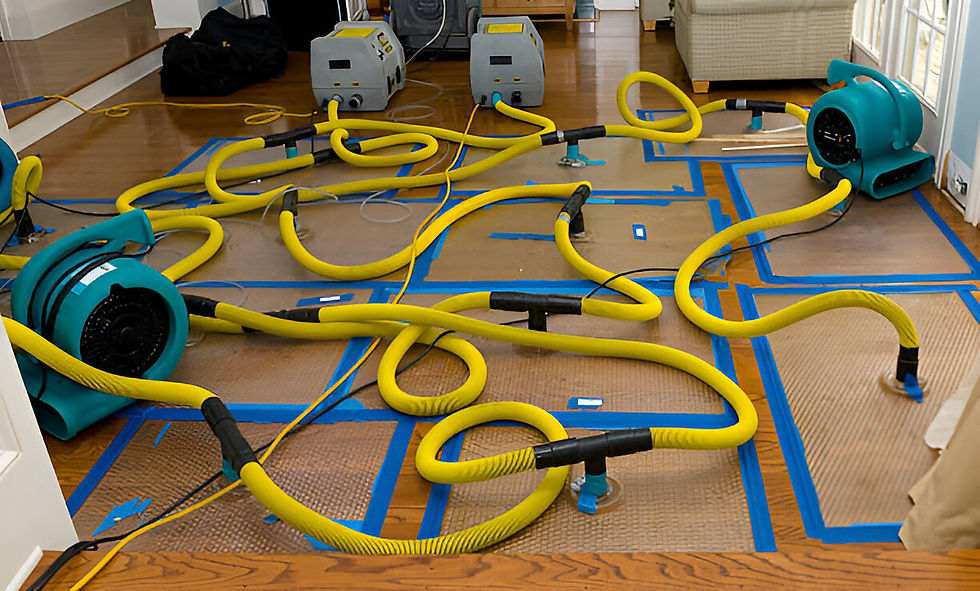What to Do When Your Fort Worth Home Suffers Water Damage
- Customer Support
- Feb 24
- 4 min read

Imagine you’re on a long road trip, cruising down the highway with a clear destination in mind. Suddenly, a massive storm rolls in, flooding the roads and forcing you to pull over. Your journey is disrupted, and you’re left scrambling to find an alternate route. Water damage in your home feels the same way—unexpected, stressful, and requiring quick thinking to get back on track.
Whether the damage is caused by a burst pipe, a leaking roof, or severe weather, it’s crucial to take the right steps to minimize the impact and restore your home efficiently. Just as you wouldn’t blindly drive through a flooded road, you shouldn’t ignore water damage. Here’s a step-by-step guide to navigating this detour and getting your home back to its best condition with the help of water damage restoration services in Texas.
Step 1: Stop the Water – Put on the Brakes
Before you can get back on the road to recovery, you need to stop the problem at its source.
Find and Shut Off the Source: Look for leaks, burst pipes, or overflowing appliances. If possible, turn off the water supply immediately.
Address Roof Leaks: If rainwater is seeping in, use a tarp as a temporary shield until repairs can be made.
Call a Professional: If you’re unsure where the water is coming from, contacting a water damage restoration company can help pinpoint the issue.
Once the flow of water is under control, you’re ready to assess the extent of the damage.
Step 2: Survey the Damage – Check the Road Ahead
Just as you’d check your GPS for road closures before continuing a trip, it’s important to assess the damage before starting cleanup.
Identify Affected Areas: Inspect floors, walls, ceilings, and furniture for visible damage.
Look for Structural Weaknesses: Water can weaken drywall, warp wood, and even compromise your home’s foundation.
Beware of Electrical Hazards: If water has reached outlets or wiring, turn off power in the affected areas and call an electrician.
Documenting the damage will be helpful when filing insurance claims or working with a restoration company in Fort Worth to repair your home.
Step 3: Remove Excess Water – Clear the Roadblocks
A flooded home is like a blocked highway—you can’t move forward until the debris is cleared. Removing excess water is a crucial step in getting back on track.
Use Towels, Mops, or a Wet/Dry Vacuum: Small amounts of water can be soaked up manually, but large-scale flooding may require specialized equipment.
Move Wet Belongings: Furniture, rugs, and other items should be relocated to prevent further damage.
Increase Ventilation: Open windows and doors to improve airflow and start the drying process.
If water levels are significant, a water damage restoration company can provide industrial-grade equipment for efficient removal.
Step 4: Dry Out the Space – Avoid Slippery Roads
Even after the water is gone, lingering moisture can cause problems down the road. Think of it like driving on wet pavement—without properly drying things out, you risk losing control.
Use Dehumidifiers and Fans: These help eliminate excess moisture and speed up the drying process.
Check for Hidden Water Damage: Moisture often seeps into walls, under floors, and into insulation. Professionals use specialized tools to detect trapped water.
For thorough drying and mold remediation services in Texas, it’s wise to bring in experts to ensure nothing is left behind.
Step 5: Inspect for Mold – Don’t Let Trouble Hitch a Ride
Mold is like an unwanted hitchhiker—it sneaks in when conditions are right and quickly becomes a major problem.
Watch for Visible Growth: Mold often appears as dark spots or fuzzy patches in damp areas.
Follow Your Nose: A musty smell is a strong indicator of hidden mold.
Call a Mold Removal Company in Fort Worth: If mold is detected, professional remediation is necessary to prevent further damage and health risks.
Step 6: Repair and Restore – Get Back on the Road
Now that your home is dry and mold-free, it’s time to restore it to its original state—just like fixing your car after a breakdown before hitting the road again.
Replace Damaged Flooring and Walls: Water-soaked carpets, warped hardwood, and damaged drywall may need to be repaired or replaced.
Sanitize and Disinfect: Cleaning affected areas prevents lingering bacteria and odors.
Seek Professional Help: If the damage is extensive, a restoration company in Fort Worth can handle the repairs and ensure everything is safe and structurally sound.
Step 7: Prevent Future Water Damage – Plan Your Next Route Carefully
Once you’ve navigated this detour, it’s time to put safeguards in place to avoid running into the same problem again.
Perform Regular Maintenance: Inspect your plumbing, roof, and appliances for leaks before they become major issues.
Install a Sump Pump: If your home is in a flood-prone area, a sump pump can help divert excess water away.
Seal Cracks and Gaps: Water often finds its way in through small openings in windows, doors, and foundations—sealing these can prevent future issues.
Final Stop: A Safe and Dry Home with Professional Assistance
Just like an unexpected road closure can disrupt your travel plans, water damage can throw your home life into chaos. But with the right steps—and the right professionals guiding you—you can navigate through the setback and reach your destination: a fully restored home.
If you’re facing water damage, don’t let it take you on a long, stressful detour. Rapid Restoration Texas specializes in water damage restoration services, offering expert solutions for drying, mold removal, and full home restoration.
Think of them as your roadside assistance for home disasters—when water damage throws you off course, the professionals are there to get you back on track.



Comments